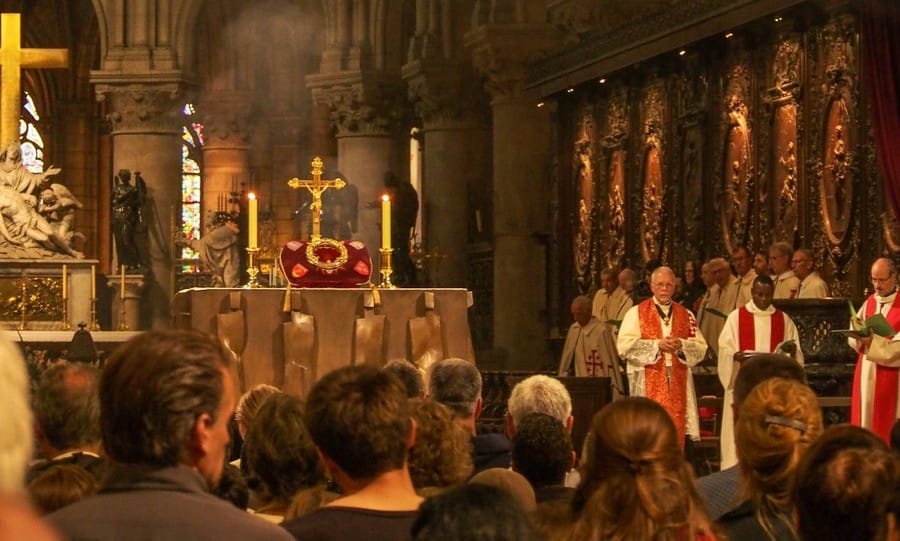The Veneration of the Holy Relics of the Saints

The 8th of November marks the feast day of the Veneration of the Holy Relics of the Saints. It is the octave day of All Saints’ and coincides with the Orthodox Church’s celebration of The Synaxis of the Holy Archangels and All The Bodiless Powers. Quite fittingly, angels are known throughout history to be fierce protectors and deliverers of the Holy Relics (and guarded the first Christian ‘relic site’: Jesus’ tomb!)
Relics are the remains of a saint’s body, possessions, or items touched by a certain saint. First-class relics are the body or fragments of the body of a saint, for example, Ex Ossibus (from the bone) or Ex Sanguine (from the blood). Second-class relics are something that personally belonged to a saint, such as the highly coveted St. Joan of Arc’s ring or St. Cuthbert’s cross. Third-class relics are items that a saint has touched or that have touched a first or second-class relic of a saint. My priest likes to joke that he’s a third-class relic because he’s shaken hands with St. Pope John Paul II.
The veneration, or “cult” of the Holy Relics is a means to honour the memory of the saints and their cooperation with God, and/or to pray for their intercession. “Cult”, in liturgical contexts, does not mean a heretical sect or manipulative group as in modern English. “Cult” as in “veneration” comes from the Latin cultus, from colere, meaning “to cultivate, honor, care for, worship”. In ancient and Christian Latin, cultus meant any expression of reverence or religious service, not necessarily “worship” in the absolute sense. Christians who venerate relics do so to honour saints and believe they are communing with them, not worshipping the objects themselves.


Critics of the Church have condemned the cult of the relics of the saints as being borrowed from pagan customs and without apostolic origin. St. Augustine, in The City of God (c. 426 AD), leverages apologetic evidence against pagans who thought miracles belonged only to their myths: “miracles were wrought that the world might believe, and they have not ceased now that the world has believed.” He recounts a contemporary miracle at Carthage, where a man was raised from the dead through the intercession of St. Stephen’s relics, as proof that divine power still worked through the saints in his own day. Even within the Church, such as at the Council of Hieria (753 AD), iconoclasm, meaning “the breaking of images”, was made the official policy of the Byzantine Empire and extended to the destruction of the relics. Shortly after the Council, the altar of the nearby Basilica of St. Euphemia was dismantled, her relics were detached and cast into the sea. Desecrations of relics and persecutions of those who defended them lasted for thirty-five years, until the Second Council of Nicaea (787 AD) reinstated the veneration of relics and affirmed their associated miracles within the canonical practice of the Church.

The reason we venerate the saints, and the driving motivation behind The Relic Project, is not because the saints are “dead”, but because, in a sense, they are more alive than we are in that they understand the True Nature of Reality and experience God as He really is. Thus, they are in constant communion with Him and enjoy the Beatific Vision: seeing God face-to-face. We far more resemble the dead than those who live in Heaven in direct communion with God. Jesus said in Luke 20:37-38, “Now that the dead rise again, Moses also showed at the bush, when he called the Lord, the God of Abraham, and the God of Isaac, and the God of Jacob. For he is not the God of the dead, but of the living: for all live to him.” They are still alive and we recognise that, which is why we venerate the relics.
St. John of Damascus, the last of the Church fathers, in the 8th century, perfectly summarises this teaching: “Christ the Lord granted us the relics of the saints as fonts of salvation, from which very many benefits come to us. … In the old law, whosoever touched a dead person was deemed unclean, but the saints are not to be reckoned among the dead. For He who is life itself, and the Author of life, was once reckoned among the dead, but He has risen, thus we do not call them dead who have fallen asleep in Christ, with the hope and faith of the resurrection.” De Fide Orthodoxa (On the Orthodox Faith).
Old Testament Law states that “He who touches the dead body of any person shall be unclean seven days” (Numbers 19:11). But since Christ ended the sacrificial system as He Himself became the final sacrifice (“the Lamb of God”), He overturned the ritual purity laws.

God, in His divine foreknowledge, knew that He would offer Himself for our salvation, rise from the dead, and establish the veneration of the saints’ relics within His Church. Accordingly, the Old Testament already contains hints of the sanctifying power of relics. In 4 Kings Chapter 13, the story of The Death of Elisha, several men were burying a man near the tomb of Elisha. Meanwhile, raiding bands from Moab invaded the land, and when they saw them, they cast the man into the tomb of Elisha; and when the man fell down and touched the bones of Elisha, he revived and stood on his feet. As with many physical realities in the Old Testament, their fulfillment is found in the spiritual order of the New: Christ becomes the true Paschal Lamb; Israel, once the ethnic descendants of Abraham, becomes the people of God through faith in Christ; and just as the bones of the prophet Elisha once restored life to the dead, the relics of the saints in the New Covenant continue to manifest God’s life-giving power to His people.

The reason that God gives miraculous power to certain relics of the deceased is that we might know that He approves of their manner of living on Earth. St. John of Damascus in De Fide Orthodoxa notes various kinds of miracles that are worked by relics: “demons are expelled, illnesses driven away, the sick are healed, the blind regain sight, the leprous are cleansed, temptations and sorrows are scattered, and every best gift descendeth through them from the Father of Lights (James 1:17), unto those who ask with unwavering faith.” (Book IV, Chapter 15).
This understanding of relics as tangible channels of divine grace persisted through the centuries. In modern times, the French priest Abbé L. Jaud expressed the same conviction in his Vie des Saints pour tous les jours de l’année: “The final object of the cult of the holy relics is God who sanctifies the saints; it is Jesus Christ, whose members the saints are. This cult is so legitimate that God Himself sometimes glorifies the relics of His saints by heavenly perfumes, by other marvellous privileges, by countless miracles.
“Let us then venerate, with respect, devotion and confidence, these precious relics which once were animated by such great souls, were the instruments of beautiful and holy works and of astonishing virtues, and which will someday be honoured by a brilliant and immortal glory. Let us value pilgrimages made to the tombs of the saints, and celebrate religiously the Feast of the Holy Relics, which appropriately follows closely upon All Saints' Day, the feast day of the splendid holy souls who are in Heaven.” (Mame: Tours, 1950).

References:
- Diocese of Lincoln. (2019, March 8). Relics of saints and how to venerate them. Diocese of Lincoln. https://www.lincolndiocese.org/news/diocesan-news/11992-relics-of-saints-and-how-to-venerate-them
- DiPippo, G. (2022, October 26). The feast of the holy relics. New Liturgical Movement. https://www.newliturgicalmovement.org/2022/10/the-feast-of-holy-relics.html
- St. John the Baptist Greek Orthodox Church. (2014, November 1). The Synaxis of the Holy Archangels and all the Bodiless Powers – November 8th. St. John GOC. https://stjohngoc.org/the-synaxis-of-the-holy-archangels-and-all-the-bodiless-powers-november-8th/
- Enduring Word. (n.d.). 2 Kings 13 – Elisha’s final prophecy and death. Enduring Word Bible Commentary. https://enduringword.com/bible-commentary/2-kings-13/
- YouTube. (2023, November 5). [The Feast of All Holy Relics]. Sensus Fidelium. https://m.youtube.com/watch?v=FMxIcxMnFRo

